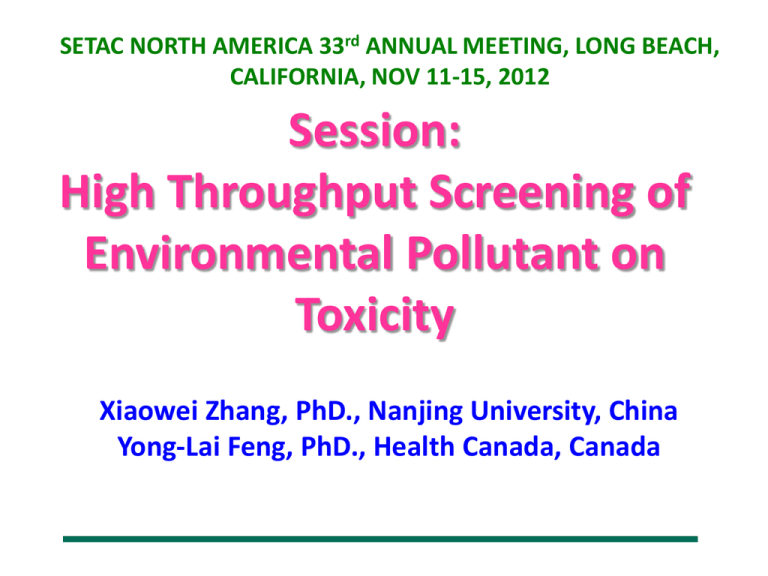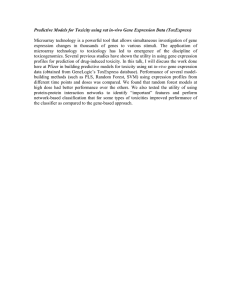Session: High Throughput Screening of Environmental Pollutant on Toxicity
advertisement

SETAC NORTH AMERICA 33rd ANNUAL MEETING, LONG BEACH, CALIFORNIA, NOV 11-15, 2012 Session: High Throughput Screening of Environmental Pollutant on Toxicity Xiaowei Zhang, PhD., Nanjing University, China Yong-Lai Feng, PhD., Health Canada, Canada Motivation • Increasing test tasks – Larger chemical inventory – Environmental Samples/Extracts • Increasing demands on toxicological knowledge – LC50, EC50, NOEC, etc. – Enzymes/Receptor interactions (Multiple) – Gene expression (Genome wise) • Increasing test capability – High throughput instruments – Miniaturized Assays • Better strategies to assess toxicity – Screening, Classification, Prioritization, Toxicity/Risk assessment – Toxicant identification, Effect-directed analysis Presentations in Our Session • Chemical tested – Organophosphate Flame retardants (Crump et al), PCBs(Fritsch et al), Endocrine disrupting chemicals(Paul et al.), nanomaterials(Cole et al.) – Micropollutants (Allionson et al) • Ecological species – E coli (Zhang et al., Lan et al.), Yeast (Lan et al.), Fish (Fritsch et al.), Chicken (Crump et al.), Phytoplankton (Cole et al.) • Testing systems – Cell line, primary cells, in vivo – reporter gene system, mRNA expression • Statistical issues – Z score (Paul et al.) – Multi variants issues (Lan et al.) • Testing Strategies – Tiered approach/stepwise approach(Paul et al.) – In combination with Instrument analysis (Allionson et al.) To: SETAC NORTH AMERICA 33rd ANNUAL MEETING, LONG BEACH, CALIFORNIA, NOV 11-15, 2012 Toxicogenomic Screening of Environmental Pollutants on Toxicity Xiaowei Zhang School of the Environment Nanjing University Toxicogenomic Screening • Genome wise study on gene expression profile by toxic chemical exposure • • Transcriptomics: Microarray/ RNA-seq Proteomics, Metabolomics • Higher throughput genomic assay/Functional Genome assays – Genome wide reporter gene assay – Gain of function assay • ORF screening assay – Loss of function assay • Mutant library screening assay • RNAi screening assay • Toxicogenomic Screening – Higher throughput – Lower cost Outline 1. Background 2. Technology and principle 3. Case studies Case 1: naphthenic acids (NAs) Case 2:PBDEs and its Analogs Case 3:Toxicological Mechanisms of ZnO nanoparticles Case 4:Chemical screening: OPFRs Case 5:Environmental Monitoring 4. Perspectives Genome Wide Live Cell Reporter Array Reporter Gene Assay--- A Successful Tool for Chemical Toxicity Assessment damage TF Activation Promoter Luciferase/GFP Gene Expression (Transcript/Protein) Cell pre-culture, over night 1800 strains/ 70% genome one strain each well Cell innoculation, 2-3 hour Chemical dosing, 2-5 min Incubation & Fluo/OD measurement, 3-6 hour Culture Data Analysis Measurement Cytotoxicity Assay (Alamar Blue) Outline 1. Background 2. Technology and principle 3. Case studies Case 1: naphthenic acids (NAs) Case 2:PBDEs and its Analogs Case 3:Toxicological Mechanisms of ZnO nanoparticles Case 4:Chemical screening: OPFRs Case 5:Environmental Monitoring 4. Perspectives Case 1、Toxicogenomic mechanims of NAs Naphthenic Acids (NAs): Pollutants from Oil Sands industry Mechanism of Toxicity 16 4 1 0.2 0.1 Fold Change inaA ilvC yfcD marR uhpT chbA insA_2 yajO ycaD yjeB yfbM xthA ypeA rbsD ileX rluE ppiD gadW ydcM yahD yaaW yfbE ybiH alaS insA_7 crl rph ybhK ydgH modF ribA feaB serC ppiB greA ptsG yfdU rpiA gnd araF yfeN sodA ybjP yjbJ hemC pitA gadX somA ybgI atpI yjbQ ymcC ybeB brnQ ligA cvrA yjfI trxA b2641 yjgA rob ftsK aceB ihfB htrL rpsM msrB pmrD yhiD rrnA accB trmU yejA ycfD bolA dppA ydcS ybfE ssb ybaY Transcriptional network database: Regulon DB Active modules identification: jActiveModules Network analysis platform: Cytoscape Time: 0 -----------3-------------6h Zhang et al., 2011. Environ Sci Technol. 45(5):1984-91 NOTEC: A promising toxicological endpoints for industrial chemicals Transcriptional Response Cytoxicity Concentration NOTEC – no observed transcriptional effect concentration Zhang et al EST 2011 Case 2、PBDEs & Analogs comparison BDE-47, HO-BDE-47, MeO-BDE-47 Su et al., 2012. Environ Sci Technol. 46(2):1185-91 OH-BDEs caused similar gene expression profiles AhR Activity of OH-BDEs Su et al., 2012. Environ Sci Technol. 46(19):10781-8 Case 3、is the toxicity of Nanoparticles due to release of metals? Different mechanisms associated with the cytoxicity by ZnO NPs and Zn2+ Lg (Concentration of released zinc ion) 3 2.5 y = 0.577x - 0.1636 R² = 0.983 2 1.5 1 0.5 0 1.5 3.5 Lg (Concentration of nano-ZnO) 5.5 Su et al EST (Submitted) Case 4、Alternative Flame Retardants Toxicity Screening No Chemicals CAS number T est Concentration Range (ppm, mg/L) Maxium Inhibition Ratio (%) IC10 after a 4hour exposure IC50 after a 4hour exposure 1 Bis(2-ethychexyl) hydrogenphosphate 298-07-7 0-5518 100 66.3 399.4 2 1,4,5,6,7,7-Hexachloronorbornene-2,3-dicarboxylic acid 115-28-6 0-3259 95 13.5 443.3 3296-90-0 0-5206 81 90.9 2403.7 4 2,2-Bis(bromomethyl)-1,3propanediol T ris(2-butoxyethyl) phosphate 78-51-3 0-6181 33 215.9 4944.5 5 T riethyl phosphate 78-40-0 0-7145 33 561.4 NA 6 T ributyl Phosphate 126-78-3 0-9768 42 105 NA 7 Metamine 107-78-1 0-1289 NA NA NA 8 T CPP 13674-84-5 0-2509 NA NA NA 3 3194-55-6 0-5814 NA NA NA 10 1,2,5,6,9,10Hexabromocyclododecane T DCPP 136374-87-8 0-1636 NA NA NA 11 T ricresyl phosphate 1330-78-5 NA NA NA 9 • • • Six alternative flame retardants (CAS#:29807-7,115-28-6,3296-90-0,78-51-3,7840-0和126-78-3)demonstrated obvious cytotoxicity . The chemicals can be classified based on gene expression profile GO terms: protein binding, plasma membrane, and stress responses Case 5、Environmental Monitoring Sediment extracts from Yangtz River(1-14) 900 800 TELIs 700 600 Low 500 Middle 400 High 300 200 100 0 Gene function Discussion & Future application • A novel genomic tools for toxicity assessment – – – – – – High throughput technology coupled with genomic information Affordable to most lab Real time monitoring of gene expression Screening: molecular pathways vs chemicals Chemical classification Field study: Effect-based Monitoring, Detection and Prioritization of chemical pollution • Tools for hypothesis testing in Predictive toxicology – Mechanism based Chemical classification – Aids in quantitative structure & activity relationship analysis – Mixture effects: mode of action • Application and future research – Chemical (eco)toxicity test – Contamination identification by the approach of effect-directed analysis – Mammalian cell based reporter array system Acknowledgement • Students – Mr. Guanyong Su (PhD candidate) – Dr Jie Fu (Postdoc ) – Miss Miao Guan • Funding Agents – NFSC – New Talents Funding (NJU) – Major State Basic Research Development Program (2008CB418102) – Program for New Century Excellent Talents in University (NCET) – Environment Canada Laboratory of Ecotoxicology and Environmental Health Thank you! • Xiaowei Zhang, PhD, Prof • • • • • Laboratory of Ecotoxicology & Environmental Health School of the Environment Nanjing University Nanjing, China Tel: (86)-25-8968 0623



